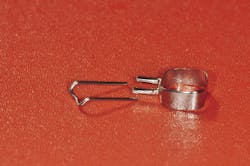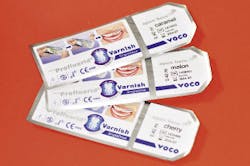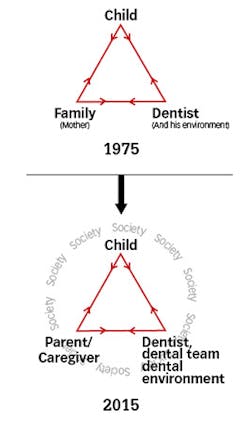Incorporating pediatric dentistry practice and principles into your general practice
Many general dentists seem to dislike the idea of treating children. They point out that children can be unpredictable. Others note that they had only a few encounters with children in a dental school rotation and it was enough to make them not want to do it again. Their mouths are too small, and they can't sit still. To top it all off, it isn't very profitable unless you're doing high volumes of work, right?
Let me tell you little bit about my background so you can understand my perspective: I've been practicing dentistry for six-and-a-half years in Florida and Texas. I graduated from dental school with the bare minimum in pediatric dental experience. I never placed a stainless steel crown or extracted a tooth on a child in dental school. I had a few associateships, seeing mostly adults for a year-and-a-half. Things were going OK, but during that time I became truly inspired with an opportunity of seeing children in a public health setting. It was so much fun! I started out just one day a week at the St. John's County Health Department in St. Augustine, Florida. My associate position at the time wasn't keeping me busy enough, so I was up for anything that was going to give me experience. Apparently there wasn't funding for my position at the clinic to be more than part-time, but I was able to find a mostly pediatric dentistry full-time position in Texas, so I moved. For a two-year period, I treated children almost exclusively. At first, I was doing sealants and small fillings—just getting my feet wet—but as my confidence and ability grew, I took on greater challenges: stainless steel crowns, space maintainers, and quadrant dentistry. When I opened my own general practice three years ago, I knew that I would always keep pediatric dentistry as a part of what I offered to patients.
Pediatric dental products I likeI speak enthusiastically about pediatric dentistry with my general practice friends all the time. It's more than just seeing small patients; it's a practice attitude! I'd like to make the case for incorporating pediatric dentistry into your practice for three excellent reasons:
1. Committing yourself to pediatric dentistry teaches you valuable dental lessons that can be applied with all patients.
Children don't like it when you hurt them, and they let you know immediately. They'll cry or just flat out tell you. They're generally honest like that. Adults don't like it when you hurt them, either, but they don't always tell you immediately. If you hurt an adult, they usually do things like never come back to your office, or tell a bunch of people, or write an online review about it. The significance of not hurting patients cannot be understated. When dentists think of great dentistry, they think of optimal esthetics and beautiful margins on restorations. When patients talk about great dentistry, they talk about how it didn't hurt. Treating children for an extended stretch or off and on keeps this fundamental principle in the front of your mind. Put the same love and care into an injection on that big biker dude that you would on a 4-year-old.
Children like it when you praise them for a job well done. So do adults. I learned when seeing children that you've got to praise them for a job well done. I probably say, "You're doing great!" or "You're doing awesome!" 20 times during a 20-minute treatment. I don't say it as many times when seeing adults, but I still tell adults at least two or three times during an appointment that they are doing great or that they did a good job.
Being gentle, positive, in control, and communicating praise are essential in treating children. When you see children regularly, you truly appreciate these principles at a high level. When you start applying these pediatric dentistry ideas and skills with adult patients, you'll find the results to be very positive.
LEARN MORE | Behavior management considerations in the pediatric dental patient
2. Pediatric dentistry allows you to incorporate fun elements into your practice, and everyone likes fun.
Treasure boxes, video games, children's play area, toys, Popsicles - pediatric dentistry as a part of your practice provides dentists with a way to incorporate something fun into the practice. Even adults who don't have children will notice that you provide these things, and they will appreciate it. Anything that can lighten the mood in your dental office contributes to the overall positive energy that your practice gives off. We have a few different choices when it comes to prophy paste and fluoride flavors. Children like to choose which ones they get. Overhead TVs/dual-screen monitors with one screen over the patient is a concept that's very popular in the pediatric dental world, and it's gaining popularity in the general practice as well. I wouldn't even consider treating a child without some SpongeBob or My Little Pony in the background. It makes the room feel happy. With adults, I prefer America's Funniest Videos or anything with puppies and kittens. Distraction techniques have always been a part of the pediatric dentistry toolbox, and the general dentist shouldn't discount how valuable this tool is, even with adults.
3. Treating children is more profitable than you think, and it's a gateway into a trusting relationship with the family.
Nitrous, local, a prophy, four sealants, a composite restoration, a stainless steel crown finished off with topical fluoride should be several hundred dollars in your practice. Even if it took you an hour to do all of that, it's still a productive hour in most general practices. There's another layer to appreciate. Parents like to put their children first, and it's especially true when it comes to the dentist! If you're performing dental treatment on a child because he or she has caries, there's a very good chance that the parent has untreated caries and other dental concerns that have been neglected for one reason or another. After parents see you successfully handle their child's treatment, and that you are gentle and caring, they are likely to schedule an appointment with you.
If your pediatric dental experience is limited, here are some tips to get started:
• Find a mentor and watch them work. Pay special attention to the language they use to manage children and parents. Observing it done well is the best place to start. The pediatric dentists I know and work with are happy to share insights and pointers with me. I refer them the cases that I don't think are appropriate to be seen in my practice, so it all works out. Remember, our competition isn't one another as dentists; our competition is ignorance and neglect in the general public. We work together!
• Baby steps - pun intended.Don't take on a patient who needs eight stainless steel crowns and pulpotomies as your first case. Your first restoration on a very young child (4- or 5-years-old) should be a one-surface composite. Your first two stainless steel crowns in contact with each other should be on a well-behaved 7- to 8-year-old, two-crown maximum.
• Remember that pediatric dentistry triangle thing from dental school? It's huge. Establishing communication and getting everyone on the same page about treatment goals, possible outcomes, and how they will be handled are so critical. If I don't think I can gain or maintain control of a situation with a parent and child, I refer.
• Work on your scripts. We all have scripts we go to, even if they aren't written down. I remember my dental school faculty sounded like tape recorders any time they would start explaining certain common procedures. You just learn the most effective way to communicate certain points, and you go to those every time. I prefer treating children with parents in the room because I can use their support to my advantage when they are properly coached. I have a pretreatment script that I go over with the parent where I emphasize how incredibly numb the child will be, how they might see a little red stuff, and how they might feel some pressure. I encourage positive words of encouragement from the parent during treatment, and minimal talking or questions as my assistant and I will providing most of the instruction. It might confuse the child to hear too many voices. This eliminates a lot of midtreatment questions, which can create disasters. My least appreciated question is, "Are they numb; are they feeling it?" when the child makes the slightest sound or movement. Children can smell fear and doubt a mile away, and as soon as it creeps into the treatment room, it's hard to get out! The confidence you express in this pretreatment script is the key to success.
Popsicles, prizes, talk, talk, talk. When I treat adults, I don't like to talk much; I like to focus. When I treat children, I like to talk the entire time, which takes practice if you're typically the quiet type. Get your assistant to help you or to at least simply repeat everything you say. In time, you'll get a routine going together. One of my favorite techniques is to talk about that Popsicle, how they're going to get to pick one when the treatment is over. Get the multicolor pack from the grocery store. Buy an extra box of red, because most kids want a red Popsicle, and I have no idea why. Every now and then, offer an adult in your practice a Popsicle after a job well done. You'll get a few takers!
LEARN MORE | Patience with the kids
Larry Dougherty, DDS, practices general dentistry in San Antonio, Texas, with his wife, Ana Paula Ferraz-Dougherty, DDS. Together they co-own Rolling Oaks Dental. A graduate of the University of Georgia and a 2008 graduate of Nova Southeastern College of Dental Medicine, Dr. Dougherty can be reached at [email protected].





